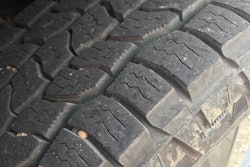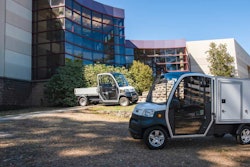 Crape myrtle bark scale appears as white, felt-like encrustations on the bark.
Crape myrtle bark scale appears as white, felt-like encrustations on the bark.Photo: F. Hale, courtesy of UTIA
As if crape myrtle, an iconic landscape plant of the Southeast, didn’t have it bad enough with the public obsessed with giving them crape murder buzz cuts, there is another threat this species has to deal with lately.
Crape myrtle bark scale (CMBS) is a pest native to Asia and it has the ability to turn a crape myrtle from a “beautiful, low-maintenance landscape tree into an unsightly, high-maintenance landscape tree,” according to the Mississippi State University Extension.
Although CMBS infestations are rarely fatal, its effects on the aesthetics of crape myrtles are not something homeowners are likely to tolerate.
What is it?
First found near Dallas, Texas, in 2004, CMBS has spread to at least 11 more states since then, according to the Texas A&M Entomology Extension.
Originally, the insect was believed to be the azalea bark scale, but since then it has been identified as a different species entirely. The pest is easy to identify, as it’s the only bark scale known to attack crape myrtles.
The adult females are around 1/10 inch in size and have a felt-like white or gray wax covering. When crushed, they “bleed” a pink liquid. They stick to crape myrtle branches and trunks, but typically gather in limb crotches and pruning sites. It can also settle under loose, exfoliating bark, making it harder to spot when the infestation is low.
The life cycle of CMBS consists of small winged adult males flying to find females to mate. Once the female has been mated with, she will lay her eggs underneath the protection of her ovisac. The eggs may overwinter within the ovisacs and then hatch mid to late April to May.
The first instar nymphs are pink, very small but mobile crawlers. They can be spread by wind or birds, but long-distance transportation most likely happens when infested plant material is moved from one state to another.
Once the crawler has settled on a tree, it will remain there for the rest of its immature life and begin to feed on crape myrtle sap. Two to three generations of CMBS can occur during one season.
What are the symptoms?
As CMBS feeds, it produces the sugary solution known as honeydew, which in turn causes sooty mold to appear on the tree’s leaves, twigs and trunk, as well as any other nearby low-growing plants that may become drenched in honeydew.
Sooty mold will leave crape myrtles black and unattractive. If this wasn’t enough, heavy infestations of CMBS can cause entire branches to be encrusted with scale.
Sooty mold is not a definite indicator of CMBS but crape myrtles with it should be examined for the presence of scale. Aphids can be another culprit behind an abundance of honeydew and sooty mold.
While CMBS may not kill its host crape myrtle, it will reduce the plant’s vigor causing fewer flowers to bloom and smaller flower cluster sizes. Infested plants also tend to leaf out later than healthy ones.
How to control it?
Keeping CMBS populations in check can be difficult and currently, there is no one perfect solution but rather a combination of best practices to adhere by.
Although heavy infestations are quite easy to spot, it is trickier to notice the insects when there aren’t as many of them. It is advised to carefully inspect crape myrtles before purchasing and to not just check the trunk and lower limbs, as they tend to be on smaller twigs and branches in the upper part of the tree, according to the Mississippi State University Extension.
According to the Clemson Cooperative Extension, crape myrtles that are grown in sunnier sites have been noted to have smaller infestations. Another cultural option is to promote the population of lady beetles, which are natural predators of CMBS, but Texas A&M says this type of control is often too late in the season to prevent sooty mold from appearing.
As for chemical options, contact sprays or systematic treatments can be used on crape myrtles but the timing of these is essential.
Contact sprays should be used as pest numbers peak, usually between mid-April and the beginning of May, followed by another treatment two weeks later.
“Separate treatments in two-week intervals are good because you want to target bark scale at their immature stage,” says Erfan Vafaie, a Texas A&M AgriLife Extension entomologist and integrated pest management specialist, who has been studying the pest. “You hit them during the peak and then two weeks later to catch those that have emerged following the first treatment.”
Vafaie says that the active ingredient bifenthrin proved to work best during his study. Crawler sprays with insect growth regulators are not recommended as a stand-alone treatment but rather one aspect of an aggressive control program.
Soil-applied systemic insecticides are currently considered the most effective treatment available. These insecticides have active ingredients such as imidacloprid, dinotefuran and thiamethoxam, which are all neonicotinoids, but pose less of a threat to pollinators as a soil drench rather than a foliar spray.
Because the soil-applied systematic treatments must be absorbed by the roots and transported up the tree, the crape myrtle needs to be actively growing for this method to be effective.
Treatments should be applied during the early portion of the growing season, anywhere from late March through May. This will target the first-generation nymphs as they begin to feed. Mississippi State encourages applying one application of soil-applied systemic insecticide each year after an infestation, even if there are no obvious signs the following year.
For heavy infestations, washing the trunk and reachable limbs with a soft brush and a solution of mild dishwashing soap can help clear off egg masses and female scales, improving the appearance of the crape myrtle, as well as removing some of the sooty mold that may be building up.









